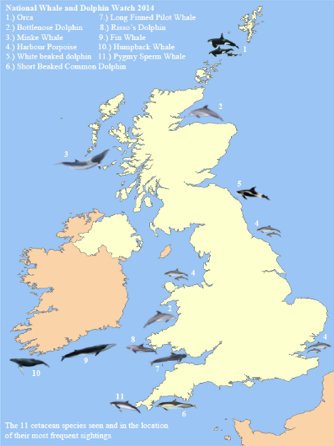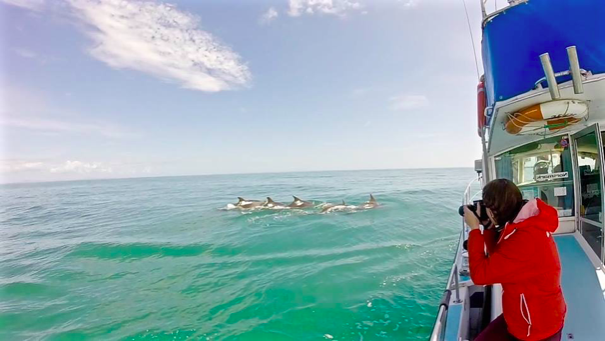Here in New Quay, Wales, we regularly see bottlenose dolphins performing highly entertaining leaps, tail slaps, and overall aerobic feats within the bay. Last month, a humpback whale was spotted in Liverpool slapping one of its fins on the water – just one of the many activities humpback whales are famous for, such as their common and spectacular breaching. However, Sea Watch recently received a sighting of a minke whale in the Channel Islands that was reportedly breaching multiple times. This was very exciting because seeing one of these large whales haul their bodies out of the water is a far rarer event than watching jumping dolphins and humpback whales. This unexpected sighting is just one of the many exciting cetacean encounters we have in the UK. With 28 cetaceans found in UK waters, it’s not hard to imagine that with a view of the ocean and a pair of binoculars, you can get a show if you’re in the right place at the right time.
Last year, during National Whale and Dolphin Watch 2014, over 600 participants were in the right place at the right time and reported 1,150 sightings of 11 species of cetaceans! National Whale and Dolphin Watch is an annual event that aims to give a general “snapshot” of what is in UK coastal waters over a short period of time, as well as to gain valuable research data and draw attention to the conservation of our marine environment. If you ever wanted to take part in a dedicated watch for marine mammals, this is definitely the event for you, and with over 100 land watch sites and 13 participating vessels last year all over the UK, chances are there’s an event near you this year. In 2014, watches took place everywhere from Cardigan Bay to Moray to Cornwall and even the Hebrides and the Orkneys. With all of the volunteers and participants at all of the sites, we managed to collect almost 930 hours of effort data, including observations of 5,426 individual animals! This year we are hoping to have an even larger event with increased widespread participation and hopefully more sightings, perhaps of even a larger variety of cetacean species.
During last year’s event, the most spotted animal was the harbour porpoise, with 725 sightings. Bottlenose dolphins were the next most frequently seen animal, followed by minke whales. With a whole weeks’ worth of sightings from around the UK, exciting observations were inevitable; some of the most memorable encounters included groups of 100 short-beaked common dolphins were seen off Pembrokeshire and the Isle of Skye, twelve killer whales were spotted off the Shetland Isles, five long- finned pilot whales were observed off Glamorgan and a pygmy sperm whale off the Cornish coast was reported.
If you are interested in getting involved with National Whale and Dolphin Watch, either participating in an existing watch or organising your own event, you can visit the website for more information.
Hope to see all of you there!
Written by Emma Weitzner , Sea Watch Research Intern 2015.



























